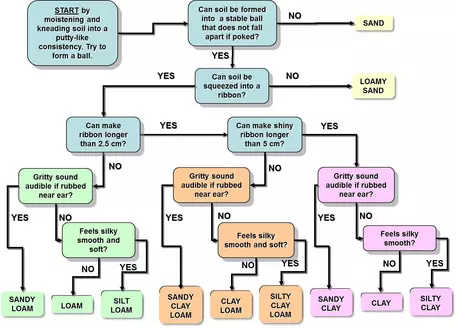Explore: Describing Soil
Introduce Soil Analysis techniques and characteristics via a series of hands-on labs and demonstrations. Educators may want to build a vocabulary wall as students are working through these labs.
To save time and materials, these hands-on labs can be set up as stations and students can rotate through them in a period of days.
Stations:
- Color
- Texture
- Percolation
- Structure
Part A. Color Labs
Key Point: Color tells us the history and origin of soil.
Time required: 30-40 minutes.

- Show students various soil samples with colors. Note: if soil samples are not available, pictures of soil can be used. Picture source: University of Idaho - The Twelve Soil Orders
- Once students have observed soil colors, use Table 2-3 from the Know Soil Know Life book to investigate the causes of soil color. Alternatively, complete this background reading The Color of Soil. This website explains soil color and the associated chemistry causing variations in colors.
Then have students complete a simple worksheet, The Color of Soil, explaining the Munsell color system.
Note: The activity requires soil samples. As an alternate resource, educators can use spice samples or the pictures linked above. - Compare the samples with either Munsell Soil Color Book or GLOBE color book available at Forestry Suppliers
Additional Links: Background Information on Soil Colors of the Continental United States:
This website has images, animated GIFs, and maps of soil colors by state: Soil Colors of the Continental United States - Complete the Color Changes in Soil lab
Time required: 60 minutes
In this lab students observe the changes in color due to mineral oxidation and reduction. Set up this lab and return to observe the changes several days later. (For example, after completing the Rain and Percolation labs. )
Color Changes in Soil
Possible alternative activity: Winogradsky Column Lab
Part B. Texture Labs
Key Point: How does soil texture affect the movement of air, water, and nutrients through the soil?

- Soil Texture Analysis wet lab. In this activity students shake a container of soil and time its settling rate. This lab is easily adapted to a demonstration.
Time required: 30-40 minutes
Soil Texture Analysis lab activity. - Follow the introductory activity with Soil Triangle Practice described here. In this activity students work with a soil sample and apply the percentages of sand, silt, and clay to determine the soil type.
- Texture by Feel Lab
Time required: 30-40 minutes.
Once students are familiar with the terminology of soil types, another simple way to determine soil texture is by simply handling a soil sample. A general procedure for this is described here Soil Texture by Feel. Educators may decide to guide students through this bifurcating key structure. Guide to Texture by Feel
Part C. Rain and Percolation Labs
Key Point: What is the relationship between the soil and the water cycle?
- Perkin through the Pores lab
In this hands-on lab, students determine the water holding and draining capacities of different soils and will investigate how organic matter increases the amount of water soil will hold.
Time required: two 30- minute activities Perkin through the Pores
- Rain and Soil Lab
In this outdoor activity, students use a ring infiltrometer made from a coffee can to investigate the rate at which water infiltrates the soil at several locations on their school grounds.
Time required: 45 minutes to 1 hour
Rain and Soil Lab
Reading alignment: Know Soil, Know Life pages 39-42
Part D. Soil Structure Labs
Key Points:
Soil condition affects how fast a soil sample will decompose in water.
Human disturbance can alter soil properties.
- Soil Glue Lab
Description:
Time required: 60 minutes
Soil Glue Lab (Acrobat (PDF) 2.8MB Dec17 20) - Erosion and Compaction Lab (On the Trail Again)
This outdoors activity is a good follow-up to the Rain and Soil lab. Students explore the relationship between soil compaction and the soil's ability to drain water.
Time required: 45 minutes
Soil Compaction
Part E. Wrap up and Conclude
Conclude this series of labs with a discussion guiding students to connect soil types to suitability for various uses, such as farming, road construction, housing developments, playing fields, etc. Encourage students to see the relationships between the soil's physical properties and soil formation.



![[reuse info]](/images/information_16.png)


